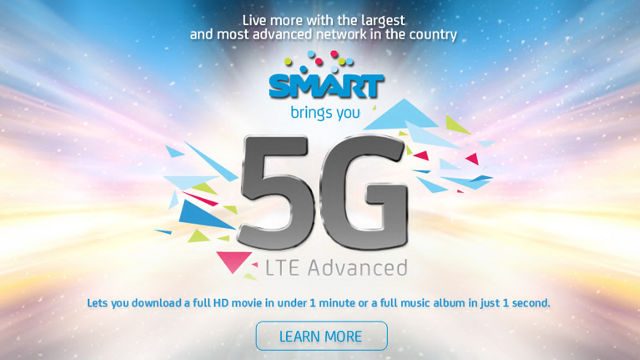SUMMARY
This is AI generated summarization, which may have errors. For context, always refer to the full article.

MANILA, Philippines – Mobile sector watchers from across the globe have called attention to the claim of Smart Communications that it is offering 5G mobile services in the Philippines, saying it’s nothing but an advertising catch-all term.
An Internet connection of such speed, they say, won’t be available until a decade or so from now.
Peter Bryer, a blogger with mobile market analysis firm CCS Insight, noted in a blog post that Smart recently announced 5G services in the Philippines, with Smart’s press release explaining that it’s now offering LTE-A (Long-Term Evolution – Advanced) services that provide speeds of up to 1 gigabit per second (Gbps).
Smart says this is “more than twice as fast as 4G services.”
Bryer quoted Smart as saying “that LTE-A is referred to as 5G by leading global operators.” He then explained how “searches on some major operator Web sites don’t always back that up, but there’s definitely a great deal of confusion in the media about the terminology.”
He continued, “Specifics of 5G services have not been defined yet and the standards are likely to be a decade away from completion, but consumers will be overloaded by the hype as more LTE-A networks go live.”
4G as a backwards precedent
In his post, he explained that this was a function of a backwards precedent. Instead of companies improving their service to comply with the technical 4G service requirements defined by the International Telecommunications Union (ITU), the extensive marketing of some connection types as 4G made the ITU align its requirements to fit the market’s semantics.
Android news website Android Authority noted that others before Smart used a catchphrase to push a new technology before it could actually offer the technically accurate speed needed.
In its report, it also mentioned that in 2010, the ITU said nobody in the US was actually using technology with 4G speeds, which according to the ITU then was technology similar to LTE-A, with speeds capable of going beyond 100Mbps.
The ITU’s change of semantics led it to term 4G technology as – in addition to LTE and Wimax technologies – “other evolved 3G technologies providing a substantial level of improvement in performance and capabilities with respect to the initial third generation systems” in place at the time, according to a 2010 press release.
In effect, Smart’s “5G” looks to be the equivalent of previously accepted 4G speeds from a definition from 4 years earlier.
In the end, Bryer is afraid of the confusion this brings, as “the lack of formal definitions and rules makes it tempting for operators and hardware makers to embellish network upgrades with bigger numbers than might be technically accurate.”
“It’s a reasonable marketing strategy in the short run,” he added, “but will lead to confusion over time.” – Rappler.com
Add a comment
How does this make you feel?
There are no comments yet. Add your comment to start the conversation.